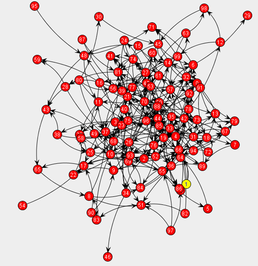The Endogenous Formation of Economic Networks
- Started
- 14th June 2010
- Ended
- 13th September 2010
- Research Team
- Camillia Zedan
- Investigators
- Antonella Ianni, Seth Bullock
Often when investigating financial systems imaginary network structures are imposed to represent, for example, the social interaction between traders. Usually, these networks are fixed in order to greatly simplify the model. However, in reality, the network can be dynamic and evolutionary, with intricate node and connection diversity that increase its structural complexity. The interaction of these elements can also result in aggregate behaviour that is complex.
This project investigates the endogenous formation of economic networks using agent-based economic modelling. It does this by creating a simulation framework for the Symmetric Connections Model [JW96] made up of autonomous agents and mapping the interaction of these agents over time.
This project also considers the introduction of errors into agent decision-making to determine whether or not the soundness of trader choice signi cantly aff ects the way in which networks are formed and any final equilibrium structure that emerges.
It is found that:
-
Under the original model, the aggregate agent behaviour is predictable and consistent with the theoretical predictions outlined in [JW96];
-
Dependent on the initial parameter settings, the model can be robust to some agent decision-making errors;
-
After the introduction of errors, the time to network formation can increase exponentially.
[JW96] M O. Jackson and A. Wolinsky. A strategic model of social and economic networks. Journal of Economic Theory, 71:44-74, 1996.
Categories
Socio-technological System simulation: Economic Networks, Human environment interaction, Social and Socio-economic Systems, Social Networks
Algorithms and computational methods: Agents, Cellular automata, Game Theory, Graph Theory
Software Engineering Tools: Eclipse
Programming languages and libraries: Java
Computational platforms: Windows
Transdisciplinary tags: Complex Systems, Computer Science, Design, Scientific Computing, Software Engineering
